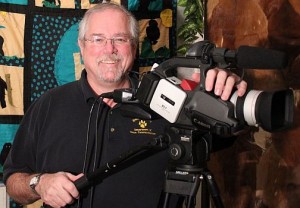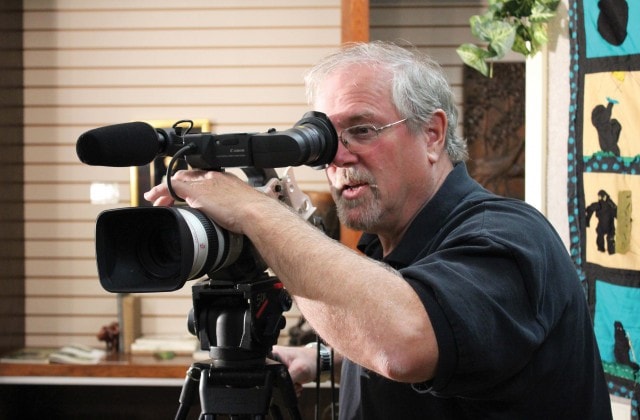Dr. Blakley Tells What’s Next On TV
Walter Cronkite may have been the most trusted man in America, but it was technology and people working on the ‘production’ side of broadcasting that made Cronkite seem like a member of your family every night. Brenau’s Mass Communication Chair Stewart Blakley can’t wait to see what comes next in the world of broadcast media and teach his students how to put it to practical use in careers.
By David Morrison
Stewart Blakley was just beginning to get his mind around the concept of three-dimensional television when, on election night in 2008, there was Wolf Blitzer, like Luke Skywalker, in the New York studio of CNN talking to and walking around holographic images of correspondent Jessica Yellin and singer will.i.am projected in from Chicago.
Although the tech wonks among us still debate whether or not that was really a hologram and the news purists bemoan whether that sort of gimmickry has any place in legitimate broadcast journalism, it got the attention of the chair of Brenau University’s Department of Mass Communications, Dr. Blakley. With a career that spans more than 40 years in and around broadcasting and broadcast journalism, Blakley has observed a phenomenal evolution in technology – advances in science that without doubt have brought forth exponential advances in the art.
“I like to play with the toys of television,” Blakley says, “and when those things advance, I like to incorporate them into classroom. I wish I could live forever so that I can see all the things are going to come.”
Basic Skills
Mass communications and broadcast journalism at Brenau focus first on the basic skills, like writing, which Blakley says will be essential no matter what careers pursue. Beyond that the idea is to teach specific skills they will need when they walk out of Brenau and into a job in a television news room. That means they will have to look at some of these futuristic-seeming technologies through a lens of real-world practicality.
Blakley at least will be on hand to apply some of the advances to the program he oversees at Brenau. In fact, the future for those programs, predicated by the legacy gift from benefactor John W. Jacobs Jr., converges on the mandate that education of future generations of Brenau students will focus on preparing them to use the evolving technology tools in their professional lives after they graduate.
Three years after the department moved to its current location in the Jacobs Building in 1993, Blakley joined the Brenau faculty and found a similar transformation was underway. “When I got here in 1996, the TV equipment was outdated, and had been for a number of years,” he recalls. “There were eight students in the department. The radio station played smooth jazz, but it was piped in from Denver, and there was very little student input.” Negotiations were underway with a cable television content provider for an agreement to allow Brenau to broadcast current movies over its Cable 95 channel, but that mostly seemed to be for the benefit of students who could use the movies in film appreciation course. None of the classes in the department were being taken by anyone outside the department. Brenau did not offer any communications classes that fit into the general education segment.
That was just a year after the first commercialization of the Internet began, but it was already clear that the technological advance would have huge impact and implications for broadcasting, journalism and all other forms of mass communication. Part of Blakley’s job then, as it is now, is to help make that happen.
Are You Experienced?
Blakley remembers vividly that day as a kid when he sat on the fender of his family’s parked car listening to a disc jockey on the radio. It was his “I want to do that” moment. He got his chance at Michigan State University as a freshman when he went to work as a disc jockey on the pre-dawn patrol at the campus radio station. Although he says “there couldn’t have been many people listening at that hour,” those who were listening heard Stewart Blakely play Jimi Hendrix’s song, “Are You Experienced?”.
Blakley had grown up in Michigan during heady times for the world-dominating American automotive industry. His family lived in the Detroit suburb of Dearborn, Mich., and Blakley graduated from Edsel Ford High School. However, he also spent some of his formative years abroad. His father was a manufacturing executive for Chrysler Corp. and moved the family to Switzerland and South Africa where he ran a plant.
“The school choices were either the private Anglican school, where they spoke English, or the public school, where they spoke Afrikaans,” he says. “Nobody in the world speaks Afrikaans.” So he attended the private school.
In those days, South Africa still was immersed in its apartheid culture, and there were constant – often violent – tensions between blacks and the minority white ruling class. “I always thought it was going to blow up into a civil war,” he says. “I am quite surprised that it didn’t.”
The communications department at Michigan State in those days was, by Blakley’s description, somewhat – ahem – Spartan. “Literally, it was ‘old school.’ The degree was in speech, arts and theater. Now it has changed its approach and is more a communications discipline, more about broadcasting and journalism.”
Perhaps he was a little under-whelmed b the experience, but after college he got his union card from the United Auto Workers and took series of jobs in the industry – first on the assembly line installing soft-tops on Lincoln Continentals, then in a factory that made fiberglass mobile homes where he got a chance to “specialize”– installing the right window in the vehicle. “Not windows, but the right-hand window,” he says. “It was a numbing experience. That is what you call ‘incentive to go back to school and get an advanced degree.’”
‘Very Technical’ Education
Blakley moved to Athens, Ohio, where he earned a master’s degree at Ohio University. He also got a chance to break into television as a camera operator at a station in nearby Lancaster, a town so small that it had only one traffic signal, which in turn had only two lights, red and green. “If both of the lights were on at the same time,” Blakley explains, “that meant it was ‘yellow.’”
For a Ph.D. he went back to Michigan – this time to the University of Michigan in Ann Arbor. His education there was “very technical,” he says, “because all of the faculty had come up through the production side” of the broadcasting industry. The first courses he taught as a graduate assistant were production. But it was a pretty primitive environment: the faculty most had been in the broadcasting business in the 1940s and ‘50s, “so we learned thing that they knew,” Blakley said. “We did radio drama productions, for example, and had props in the studio so we could make sound effects – windows opening and shutting, car doors slamming. And the television production was all with old black-and-white equipment, like cameras with turret lenses (normal, wide-angle and telephoto that pivot over the shutter)” rather than more sophisticated single zoom lenses.
Blakley spent some time as a news director at a television station in Illinois before moving to Baltimore. There he taught for seven years each at Morgan State University and Towson State University before making the move to Brenau.
 Just as he spearheaded the development and production of a weekly news talk show at Brenau for 10 years, Blakley is now looking for the next thing that new technologies will facilitate. Both the television and radio stations have migrated to digital technology, which makes it easier to develop multimedia “convergence” platforms. Also, with digital signals that can stream live over the Internet, the Brenau programs no long need to remain local. They’re literally open to the world.
Just as he spearheaded the development and production of a weekly news talk show at Brenau for 10 years, Blakley is now looking for the next thing that new technologies will facilitate. Both the television and radio stations have migrated to digital technology, which makes it easier to develop multimedia “convergence” platforms. Also, with digital signals that can stream live over the Internet, the Brenau programs no long need to remain local. They’re literally open to the world.
For television, Blakley explains, “digital means crisper, better pictures,” but it also means that you can have that kind of visual data streaming as a sideband to a radio broadcast and have both audio and video files inside a “print” article on a Web page. But a year from now these simplistic digital convergences could very well seem primitive. Despite something of a slump in consumer enthusiasm to 3-D television, Blakley remains excited about the technology and the possibilities that it opens up event in covering the news.
But holograms? Come on! That’s a little “out there,” isn’t it?
The most famous of these types of images that are more 360-dimensional (you literally can walk around them) projected by the vacuum cleaner-like robot R2D2 in “Star Wars” of Princess Leia’s pleading, “Help me, Obi-Wan Kenobi. You’re my only hope.” But that, like the one on CNN, was merely a two-dimensional picture of what purported to be a hologram. But are there really practical applications for holograms in commercial television and television news – other than, say, giving you the ability to walk behind a political candidate while he’s lying to you to see if his fingers are crossed?
For one thing, the cost and logistical challenges will have to come way, way down, Blakley explains. The little CNN election night stunt reported involved use of 39 cameras that photographed the subjects from as many angles as they could.
But, from Blakley’s perspective, the effectiveness of broadcast media since its inception has been making the media experience more personal for members of the audience because it involves more of their senses in the experience. How much more personal could it get than, say, have the president of the United States deliver the State of the Union message while standing in front of your family’s fireplace?

